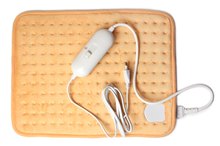Exercises to Relieve Nerve Pain in the Thigh
Nerve pain in the thigh is often caused by the pressure put on a nerve in another part of the body, such as occurs with sciatica. Sciatica is actually a pinched nerve in the lower back, but the pain radiates down the leg into the thigh.
Contrary to popular belief, it is important to exercise when you are experiencing nerve pain like sciatica. Cardiovascular exercise combined with gentle stretching is recommended to relieve discomfort and help heal sciatica.
Low-Impact Cardiovascular Exercise
Regular cardiovascular exercise is important to maintain total body fitness, even when you are suffering from nerve pain in your thigh.
In fact, moderate, low-impact cardiovascular exercise can help reduce some inflammation and the irritation causing your nerve pain and help prevent it from coming back. It is important that the exercise be low-impact, meaning it doesn't put a great deal of stress and strain on the joints or lower back.
Walking is a great form of low-impact cardiovascular exercise. You should get at least 30 minutes of cardiovascular exercise three to four days per week.
- Regular cardiovascular exercise is important to maintain total body fitness, even when you are suffering from nerve pain in your thigh.
Hamstring Stretch
Stretching Exercises for Hip Pain From a Pinched Nerve
Learn More
Your hamstrings are large muscles on the top-back of your thigh. Often, sciatic pain radiates down one side of your body through your hamstring. Whether this is where you are feeling the pain, it is important to keep your hamstrings long and flexible. Hamstring stretches also help reduce pressure in the lower back. An easy hamstring stretch to do when you are feeling pain or even when you aren't feeling pain is a forward bend. Stand up tall with your hands on your hips. Squeeze your shoulder blades together and broaden your chest as you fold forward, keeping your spine straight.
Stop when your spine begins to round and release your fingertips to the ground or to your shins.
Hold here for 10 to 20 seconds and then slowly rise back up. Do this daily.
- Your hamstrings are large muscles on the top-back of your thigh.
- Stop when your spine begins to round and release your fingertips to the ground or to your shins.
Piriformis Stretch
The piriformis muscle is a small muscle in the lower back that connects to the pelvis. Sometimes, the sciatic nerve gets compressed by the piriformis if it is too tight, and this can be the cause of your pain. That's why it's important to stretch the piriformis muscle regularly. Lie on your back on the ground. Bend your knees and place your feet flat on the floor. Take the leg on the side on which you feel pain and cross it over the other leg at the knee, so that your knees are stacked on top of each other. Now, lift both feet of the floor and interlace your fingers around the back of the bottom thigh.
Keep your head and shoulders on the floor and pull your legs in toward your chest.
Hold here for 20 seconds and switch sides to maintain balance in the body. Perform this stretch daily and whenever you feel pain.
- The piriformis muscle is a small muscle in the lower back that connects to the pelvis.
- Take the leg on the side on which you feel pain and cross it over the other leg at the knee, so that your knees are stacked on top of each other.
Spinal Twist
Stretches for Thoracic Paraspinal Muscles
Learn More
Spinal twists help to realign the spine, as well as any muscles and nerves that might be pinched or out of place. You can do any easy spinal twist right at your desk whenever you feel pain. Sit in a chair facing forward with your feet flat on the floor. Keep your hips centered on the chair, but turn your upper body to the left.
Use your hands on the back and side of the chair to help rotate your torso even further to that side. Hold here for 20 seconds and release. Switch sides.
- Spinal twists help to realign the spine, as well as any muscles and nerves that might be pinched or out of place.
- Use your hands on the back and side of the chair to help rotate your torso even further to that side.
Related Articles
References
- Spine-Health: Sciatica Causes and Exercises
- Ropper AH, Zafonte RD. Sciatica. N Engl J Med. 2015;372(13):1240-8. doi:10.1056/NEJMra1410151
- Stynes S, Konstantinou K, Ogollah R, Hay EM, Dunn KM Clinical diagnostic model for sciatica developed in primary care patients with low back-related leg pain. PLOS ONE 2018;13(4):e0191852. doi:10.1371/journal.pone.0191852
- Koes BW, van Tulder MW, Peul WC. Diagnosis and treatment of sciatica. BMJ. 2007;334(7607):1313‐1317. doi:10.1136/bmj.39223.428495.BE
- Dulebohn SC, Ngnitewe Massa R, Mesfin FB. Disc Herniation. Treasure Island, FL: StatPearls Publishing. Updated August 1, 2019.
- Shim HY, Lim OK, Bae KH, Park SM, Lee JK, Park KD. Sciatic nerve injury caused by a stretching exercise in a trained dancer. Ann Rehabil Med. 2013;37(6):886-90. doi:10.5535/arm.2013.37.6.886
- Coulombe BJ, Games KE, Neil ER, Eberman LE. Core stability exercise versus general exercise for chronic low back pain. J Athl Train. 2017;52(1):71-72. doi:10.4085/1062-6050-51.11.16
- Albert HB, Manniche C. The efficacy of systematic active conservative treatment for patients with severe sciatica. Spine. 2012;37(7):531-542. doi:10.1097/BRS.0b013e31821ace7f
- Bueno-Gracia E, Pérez-Bellmunt A, Estébanez-de-Miguel E, et al. Differential movement of the sciatic nerve and hamstrings during the straight leg raise with ankle dorsiflexion: Implications for diagnosis of neural aspect to hamstring disorders. Musculoskelet Sci Pract. 2019;43:91-95. doi:10.1016/j.msksp.2019.07.011
- Hopayian K, Song F, Riera R, Sambandan S. The clinical features of the piriformis syndrome: a systematic review. Eur Spine J. 2010;19(12):2095-2109. doi:10.1007/s00586-010-1504-9
- Dahm KT, Brurberg KG, Jamtvedt G, Hagen KB. Advice to rest in bed versus advice to stay active for acute low-back pain and sciatica. Cochrane Database Syst Rev. 2010;(6):CD007612. doi:10.1002/14651858.CD007612.pub2
- Bonasia DE, Rosso F, Cottino U, Rossi R. Exercise-induced leg pain. Asia Pac J Sports Med Arthrosc Rehabil Technol. 2015;2(3):73-84. doi:10.1016/j.asmart.2015.03.003
- Lewis RA, Williams NH, Sutton AJ, Burton K, Din NU, Matar HE, Hendry M, Phillips CJ, Nafees S, Fitzsimmons D, Rickard I, Wilkinson C. Comparative clinical effectiveness of management strategies for sciatica: systematic review and network meta-analyses. (PDF). Spine J. 2015;15(6):1461-77. doi:10.1016/j.spinee.2013.08.049
Writer Bio
Jody Braverman is a health and fitness professional and writer in Seattle. She has been a personal trainer and yoga instructor for almost a decade and is passionate about movement and helping people lead active, healthy lives.









